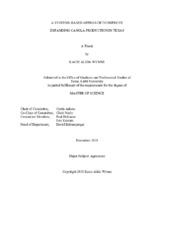| dc.description.abstract | The United States is currently a net importer of canola (Brassica napus L.) and, to
become more self-sufficient in production of the commodity, the USDA has prioritized research
that will allow expansion of canola production into new areas. Canola offers a possible solution
for agricultural producers in Texas and the broader southern region looking for a winter
rotational crop for traditionally limited cropping rotations, but the lack of research and data on
agronomic management practices specific to the region is a roadblock to adoption.
The first objective of this project was to identify the optimum row spacing and planting
density to achieve maximum yield and oil productivity in fall-planted spring canola in the
southern US. Replicated studies were carried out at College Station and Perry, TX during the
2017-2018 winter growing season. Treatments included three row spacings (19, 38, and 76 cm),
three planting rates (1.7, 3.4, and 5.0 kg ha^-1), and two canola cultivars (cv. ‘HyCLASS 930’ and
cv. ‘HyCLASS 970’). A 15% reduction in yield was observed at the wide 76 cm row spacing at
Perry, showing risk in planting on rows this wide. The lack of differences in yield among the
tested planting rates suggests that rates can be dropped as low as 1.7 kg ha^-1 in this environment,
far lower than the commonly recommended 5.6 kg ha^-1. The average yield at Perry (2787 kg ha^-1)
was comparable to the average 2017 yield in Canada (2300 kg ha^-1), indicating great potential for
fall-sown spring canola production in Texas.
The second objective was to assess potential variety-specific residual chemical effects of
wheat chaff on canola germination and early growth in laboratory and outdoor pot studies. In the
laboratory study, designed to test the most severe possible effects, canola germination and
radicle elongation rates were measured with exposure to aqueous wheat chaff extract solutions at
six concentrations (0, 5, 25, 50, 75, and 100 g L^-1) in petri dishes. Increasing chaff concentration
initially slowed germination, but no differences in germination percentage were observed after
four days. Persistent negative effects on radicle growth were observed, as radicle length was 45%
lower with exposure to 100 g chaff L^-1 after four days. In a pot study repeated with chaff from
two sources, experimental treatments included two soil types, chaff of 15 wheat cultivars, and
untreated controls. Pots were topped with chaff, placed outside for the summer, and planted with
canola in the fall. Wheat chaff did not affect germination, but early growth increased by an
average of 23% in 13 of 15 chaff varieties. These results indicate that chemical properties of
wheat chaff can negatively affect canola seedlings, but these negative effects are unlikely under
field conditions. | en |


